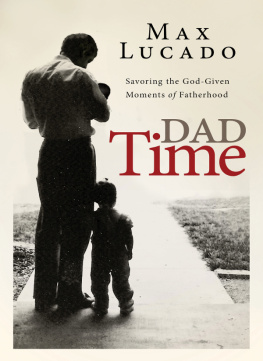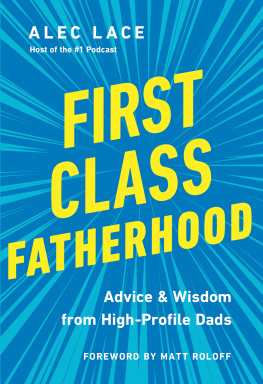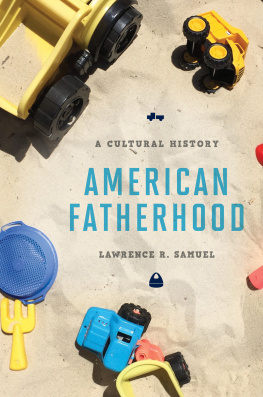To you, curious reader:
May you find as much value in reading
as we found in composition.
Cherish your children.
Hold them closely.
Love them
and
allow yourself to
be loved in return.
There is no greater joy.
ACKNOWLEDGMENTS
Josh Misner, Ph.D.
I would like to first and foremost acknowledge my partner and spouse, Stacie, for without her love and guidance, I would barely be a fraction of the father I am today. It takes guts and perseverance to show someone the right path sometimes; especially when that someone is about as mindless as I was at the time, but Im glad you did, as I am a better and more mindful dad because of your influence. Secondly, I would like to acknowledge my children: Darion, Marissa, Isabella, and Parker. You four are my world, my life, and my reason for believing that each and every day that I wake up to spend sharing this world with you is potentially the best day of my lifeyet another chance to get it right and try again, begun with a hug and punctuated by a kiss. I love you all, and this is for you. Lastly, I would like to acknowledge my coauthor, Hogan, who took a chance by offering a helping hand to a dad he didnt even know at the time, which led to a 90-minute phone conversation that concluded with the ideas to fill these pages. Keep walking the walk!
INTRODUCTION
Josh Misner, Ph.D.
I n 2012, one of the largest diaper manufacturing companies in the world, Huggies, created an ad campaign called Dad Test, which proposed that its diapers were so efficient and foolproof that even fathers couldnt put them on in such a way as to result in a leak. The ad communicated implicitly that men, in general, are not skilled enough to put a diaper on an infant properly. The resultant backlash against Kimberly Clark, the parent company for Huggies, was so severe that the company quickly removed all traces of the ad from their webpages and social media. Despite the backlash, several men and women alike defended the original ad with comments such as:
GIVE ME A BREAK! Is that all you guys have to do is sit at home and bitch about a commercial ?. It was funny and from looking at the commercial , I did not assume it was targeting just stay at home dads, it targeted all dads. And of the 66+million fathers in America, Id be willing to bet there are some that react as the actors in the commercial [sic]. As for the approximate 158,000 stay at home dads, change the channel to Jerry Springer and stop whinning [sic].
OMG! Are we raising our sons to become such a bunch of pansies! Get over it and get over yourselves - its a COMMERCIAL!!!!!!
The problem these days is everyone has lost their sense of humor.
According to a 2000 study published in the Journal of Marriage and Family, comic books throughout the 20 th century showed that the bumbling dad stereotype reaches back to the 1940s in print, with television and movies following suit soon after. Take, for example, Ray Romano from Everybody Loves Raymond, Peter Griffin, from Family Guy , Homer Simpson, from The Simpsons, or Al Bundy, from the hit 1980s show, Married With Children .
What do the Huggies commercial and these television dads have in common? They represent a larger societal view of fathers as inept parents, both reflecting existing views, as well as continuing to reinforce them with people already holding such opinions, or spread such views to people easily influenced or who have little to no opinion on the matter. Such is the power of media influence. The longer and more frequently a certain message appears, the greater its impact upon societal views at large.
In 1983, Michael Keatons portrayal of Mr. Mom asked audiences to ponder the question, what would happen if mom and dad switched places, where mom became the provider and dad, the caregiver? The story is an entertaining tale, undoubtedly so, as it is now a beloved film classic by many: the story of a man who confidently takes on the role of stay-at-home dad, only to find it far more challenging than he had ever imagined. By the end of the movie, he learns a valuable lessonthat his children and family as a whole are far more important to him that any career could possibly become. However, the movie had the unfortunate side effect of portraying all dads as potentially bumbling, which, when added to all of the other portrayals throughout television, film, and print, serves to create a societal stereotype that proves difficult to challenge.
Within the last few decades, men have started taking on more responsibility within the context of parenting. Single fathers are the single fastest growing family demographic in terms of percentage change each and every year for the last decade. More and more men opt to either stay at home to be full-time parents to their children, or work from home, whenever their careers permit. Working fathers spend considerably higher amounts of time with their children every week. All around the country, more and more dad support groups are created every year, some of which serve a purely social purpose to get dads together and swap stories while their kids play. Other groups serve as an educational or even therapeutic purpose by giving voice to mens tightly bottled emotions, the result of emotional stifling (which will be discussed at length later in the book).
Simply put, its a great time in history to be a dad. So, why, then, do we continue seeing story after story or headline after headline about deadbeat dads, dads who run out on their families, or the classic case of the child support avoiding, absentee father? Simply put, those stories have momentum. They are based on the very same stereotypes we see in the media, which do have a certain basis in reality, but gone are those days for the vast majority of men in modern society. What this book proposes to accomplish is to derail that momentum and rewrite or rebrand the very nature of fatherhood, or at least, our perceptions of it.
Beginning with Mary Wollstonecraft in the 1700s and continuing up through the 1970s, the feminist movement sought equal treatment for women in various arenas, including politics, social issues, and economics. As of the writing of this book, that notion of gender-based equality still has strides to make until that vision is complete. The very definition of feminism suggests that equality is not the sole prerogative of women, because for men and women to be truly equal, we must examine all fronts upon which inequality exists. One of those fronts is in the homein the family.
Fathers and mothers deserve equality within the realm of the family. This means that both women and men have the potential to be nurturing, compassionate, emotionally available, and mindful parents to their children. This also means that both men and women have the capacity to be providers, protectors, educators, and disciplinarians to their children. The beauty of this truth is that both men and women can fulfill each of these roles and moreeven if it means they take differing paths to arrive at that goal.
One of the aims of this book is to show how, in many cases, mothers have become the preferred parent, or an automatic choice, such as a school contacting a childs mother because they mindlessly (not an insult, but a technical term we will address later on) assume that is the parent responsible for handling school-related issues. In much the same way women were once told that they could not perform in the boardroom, lead in politics, fly aircraft, or fight on the front lines, due to their supposed natural capabilities, men are also being taught that they are limited in what they are able to provide as far as their parent-child interactions are concerned. In much the same way that pioneering women proved to the world that women are just as capable as men, this book seeks to employ a simultaneous storytelling and research-based approach to show that the opposite is also true: men and women are equally capable, yet remarkably diverse parents to their children.
Next page





